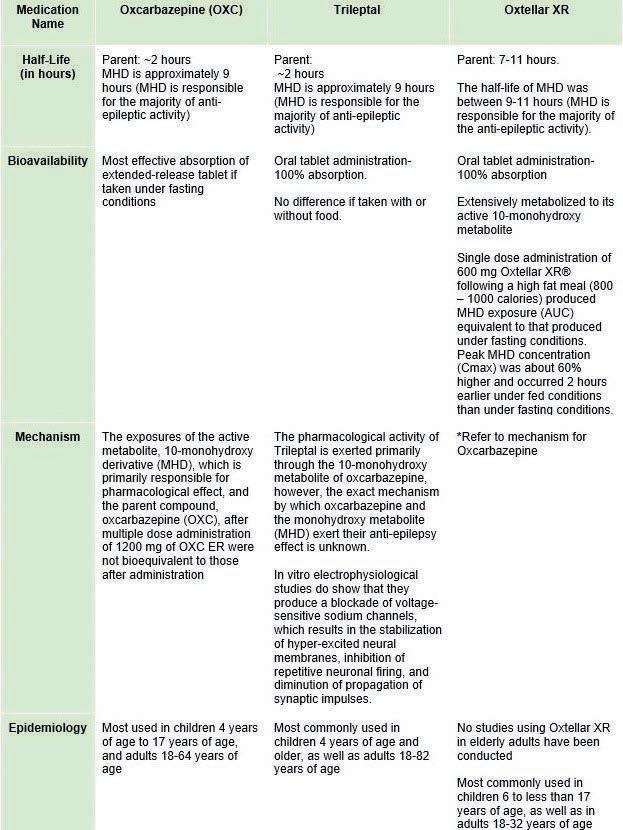Scholarly Research In Progress • Vol. 5, November 2021
Measuring the Change in Use of Generic Oxcarbazepine (OXC) Versus Brand Names for Medicaid Enrollees Throughout the United States in 2018-2019 Isra Amin1*‡, Rizelyn Benito1*‡, Daniela Velasquez1*‡, Megan Yeung1*‡, and Alyssa Trajan1* ¹Geisinger Commonwealth School of Medicine, Scranton, PA 18509 *Master of Biomedical Sciences Program ‡ Authors contributed equally Correspondence: myeung@som.geisinger.edu
Abstract Background: There is a contentious debate on the efficacy and cost between the use of generic versus brand name antiepileptic drugs (AEDs). Oxcarbazepine (OXC) is a common antiepileptic drug available as generic oxcarbazepine and as brand names Trileptal and Oxtellar XR, which Medicaid covers for qualifying applicants through a system called Commonwealth of Pennsylvania Access to Social Services (COMPASS). This study analyzed the nationwide 2018 and 2019 Medicaid drug utilization datasets to compare the usage of generic oxcarbazepine and its brand names Trileptal and Oxtellar XR for persons throughout the United States. Medicaid has restrictive administrative policies such as prior authorization (PA), preferred drug lists (PDLs), and step therapy (ST) which create socioeconomic disparities in public care by restricting Medicaid patients’ access to brand name alternatives. The hypothesis proposed that generic oxcarbazepine will be utilized significantly and constantly more in both years and therefore the change in generic and brand name use from 2018 to 2019 will not be significant. Methods: A heat map for each drug and year was created per 100,000 Medicaid enrollees. A pie chart for each year was made to compare the prescribed amount of generic medication, oxcarbazepine, to the brand-name medications, Trileptal and Oxtellar XR. A bar graph was created to show which states had the most oxcarbazepine use, and a two tailed paired t-test was used to establish the significance of our data. Results: The t-test revealed that there was not a significant change in use for generic oxcarbazepine (p = 0.513) and Oxtellar XR (p = 0.953). However, Trileptal (p = 0.025) had a significant change in use from 2018 to 2019. Conclusion: Our hypothesis was confirmed. The change in use of generic oxcarbazepine and Oxtellar XR between the years 2018 to 2019 was insignificant, but the change in use of Trileptal was significant. Prescriptions for years 2018 and 2019 were largely generic oxcarbazepine with 94% and above. Future plans include exploring socioeconomic implications between generic oxcarbazepine and brand name drugs on individuals with Medicaid as well as the relationship between the prescription prices of generic oxcarbazepine, Oxtellar XR, and Trileptal and how it varies per state based on preference.
Introduction There are approximately 3 million epileptic adults in the United States (U.S.) who use anti-epileptic drugs (AEDs). However, AED medications are also prescribed for diagnoses such as
92
bipolar I disorder, mania and others. As these drugs have biologically sensitive effects, a larger contentious discussion on the efficacy and access of generic and brand AEDs has ensued. This controversy affects patients who have Medicaid as some brand-name medications are not covered by Medicaid plans, leading patients to pay more for brand-name medications (1). Oxcarbazepine is a common anti-epileptic drug often prescribed to treat epilepsy and personality disorders and is available as generic OXC and as the brand-name alternatives Oxtellar XR and Trileptal. Both generic and brand-name AEDs vary slightly in chemical compounds due to different fillers that can lead to rare side effects in some patients (2). Table 1 denotes biochemical differences between generic OXC and its brand names. Although the drugs are meant to have similar clinical outcomes, patients and providers prefer to prescribe brandname medication compared to generic medication, as they believe it treats illnesses and diseases more effectively (3). The determination of generic drug efficacy of AEDs is important to establish, as it is central to maintaining ethical patient care and establishing pharmacological consistency in its effects. This requires AEDs, such as oxcarbazepine, which is often used in combination with other medicines, to be biologically effective, sensitive, and consistent with a patient’s history. Since patients react differently to various pharmacological agents, it is critical that generic and brand names be readily available. However, restrictive Medicaid policies like prior authorization that require providers of each state’s Medicaid agency in order to control and reduce Medicaid costs before prescribing a drug are enacted to hinder access for brand name drugs due to governmental costs (4). Additionally, Medicaid programs operate a preferred drug list (PDL) that lists generic drug brands and requires healthcare providers to prescribe generic brands before brand-name alternatives. This process is called step therapy (ST) where in order to obtain brand-name drugs, Medicaid patients would need to perform poorly on the generic options — patients have to either experience worsening conditions or have no effect with the drug prescribed (5). However, ST varies across states through a mechanism called “step edits” which are “fail-first” policies that insurance companies enact to ensure generic medications are tried first to curb costs. For example, according to the Epilepsy Foundation, Pennsylvania is the only state that is a quadruple step edit state for AED access. The continued implementation of step edits prompts contentious debate, as controlling Medicaid costs through ST results in long-term ineffective treatment and harmful effects. In particular, there exists a disparity between usage of brand name of generic OXC,












































